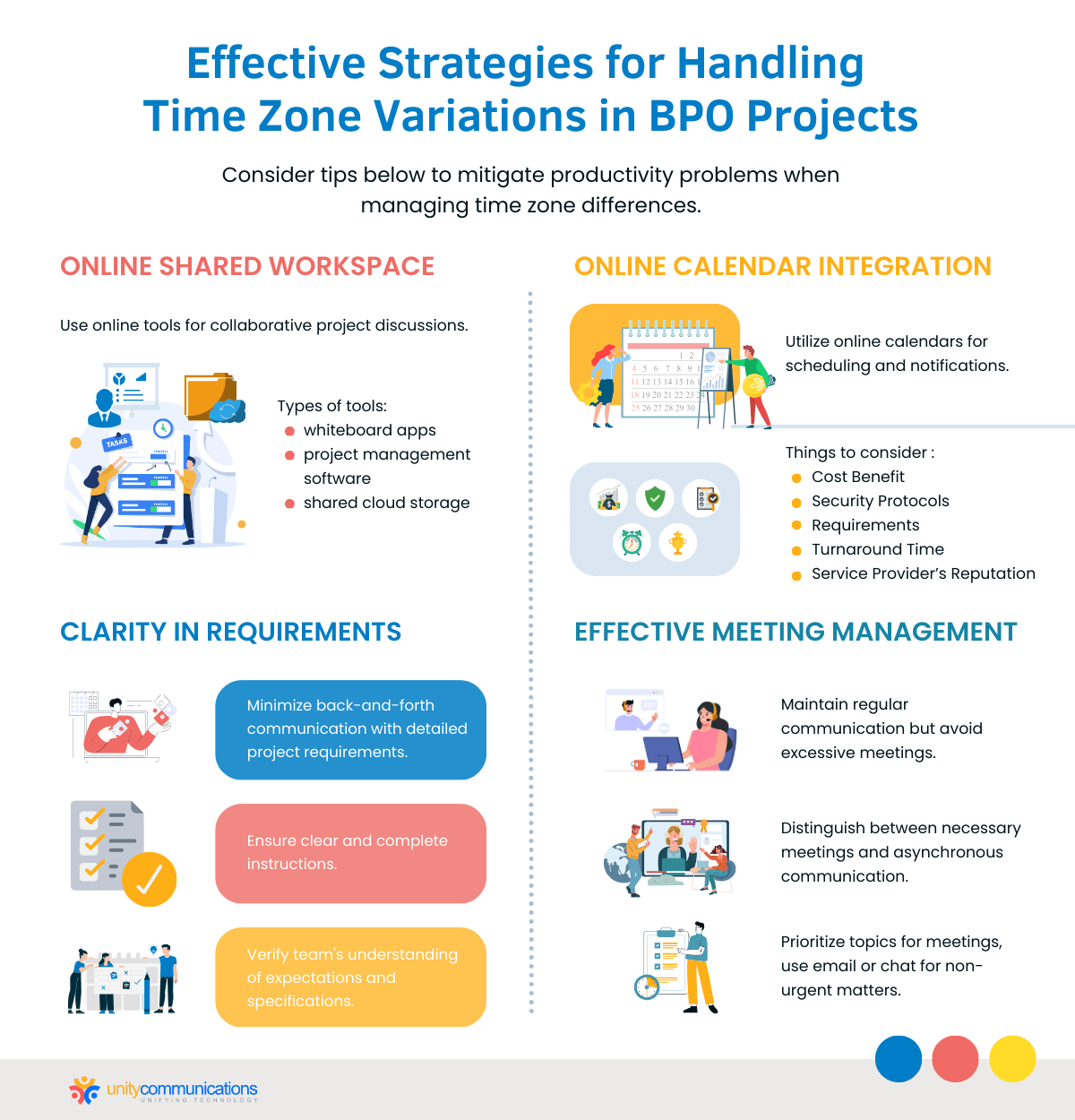Written by Allie Delos Santos
Contents
When companies consider business process outsourcing (BPO), they often have concerns about how time zone differences affect operations and project management. Some view outsourcing to a country with different working hours as a challenge. However, the truth is that maximizing time zone differences offers incredible, untapped benefits.
This article explores how to use time zones properly when outsourcing. It also shares tips on managing time zone differences in outsourced work and its advantages.
How to Use Time Zones When Outsourcing
One of the best ways to use time zone differences when outsourcing is the “follow the sun” approach. This approach leads to 24/7 operations because the outsourcing team continues the work during the client’s off hours and delivers results when internal staff clock in the next day. This round-the-clock approach speeds up project timelines and reduces response times.
Even if working 24/7 is not necessary, it can be a benefit. You start each work day a step ahead. For example, having a graphic designer who works overnight means you can send a task today and wake up to a completed draft tomorrow.
This 24/7 approach is in high demand in the customer service, e-commerce, logistics, and tech sectors. For most BPO clients, “level of support’ is the most important quality they seek in a managed service provider.
Here is how to use time zones when outsourcing:
- Provide 24/7 customer support. Regular operating hours are obsolete, especially if you have a website or promote products online. 24/7 customer care is a must to assist buyers. So, start by setting up multidisciplinary contact teams to work outside your office hours. These teams can handle tickets and create a full report at the end of their shift.
- Achieve shorter project timelines. Using the “follow the sun” method, teams can accomplish projects faster using a relay-style strategy of delegating tasks around the clock to keep work moving. This strategy is effective but requires good communication and regular online meetings to check progress and address issues.
A “follow the sun” approach also creates collaboration issues and needs extra coordination to avoid the effects of insufficient real-time communication, such as potential misunderstandings and rework. However, even if they are halfway worldwide, third-party teams can follow your work schedule if necessary.
The worldwide outsourcing industry is well-established, and employees are accustomed to working the night shift to fit the client’s needs. Just communicate your requirements to your service provider and include them in the service-level agreement (SLA) before finalizing the partnership. Learn how to write an SLA to clearly define your outsourcing needs for a provider.
Tips for Managing Different Time Zones in BPO Engagements

First, what is BPO? It is the process of subcontracting areas of operations to a third party that can perform the project successfully with greater cost efficiency. Often, companies employ third-party service providers in offshore or nearshore locations to maximize savings.
Outsourced projects require effective communication and seamless coordination. However, dispersed teams sometimes go back and forth with emails. Hence, productivity stalls, and the influence on efficiency is dramatic.
Here are some suggestions to address productivity issues effectively:
- Give the team an online shared working space. Furnish your team with an online collaborative platform where they can discuss project particulars and leave comments or notes while concurrently editing documents. Numerous online tools are available, encompassing whiteboard applications, project management software, and shared cloud storage.
- Establish an online calendar app. Employ online calendars like Google Calendar, Microsoft Outlook, or Zoho to facilitate the identification of available meeting slots and promptly notify team members about upcoming calls.
- Be clear about the requirements. To minimize the need for repetitive communication, ensure thoroughness when discussing project prerequisites. Offering precise and comprehensive instructions to the external team promotes quality and compliance. Collaborate closely with the team to confirm their understanding of your expectations and specifications.
- Conduct mindful meetings. Effective communication is pivotal in successful outsourcing; however, it does not equate to continuous meetings. Overburdening your staff with incessant and unnecessary meetings can often be counterproductive. Instead, reach a consensus on which topics necessitate a meeting and which can be addressed asynchronously via email or chat.
Advantages of Time Zone Differences When Outsourcing

Now that you know how to use time zones when outsourcing, let us discuss its benefits. The advantages of time zone differences when outsourcing differ based on how long the difference is.
Outsourcing destinations with one-shift time differences from the U.S. are Eastern European countries. Depending on the location, these countries range from five to ten hours ahead of the U.S. The advantages of one-shift time zone outsourcing include the following:
- Real-time communication and collaboration are limited but can still happen.
- Collaboration between teams is organic, although slightly rushed.
- With proper procedures and systems, work moves continuously for most of the workday.
- Someone is mostly online, which is ideal for tech support companies.
- It covers a wider range of time zones.
BPO destinations with two-shift time zone differences from the U.S. include the Philippines, India, and Vietnam. This difference ranges from ten to 15 hours ahead of the United States. Aside from 70% cost savings, the advantages are the following:
- Someone is always online to provide round-the-clock customer service.
- Continuous workflow since the offshore team accomplishes the task around the clock.
- Companies achieve higher productivity and improved efficiency.
Companies worldwide have been outsourcing and taking advantage of time zone differences, especially for customer service. Below are examples of companies that outsource customer support:
- AT&T
- Verizon
- Telstra
- Comcast
- Vodafone
- Softbank
So when are time zone differences not ideal? Keep operations in-house or outsource them locally to avoid time zone differences when:
- The project requires constant communication and thorough management.
- The outsourced work is part of your core competency, and
- External teams depend on synchronous communication with the in-house department.
The Bottom Line
Outsourcing often implies managing time zone differences among different parties and team members, whether nearshore or offshore. BPO clients must learn to use time zones wisely when outsourcing to fully reap its benefits.
Although many businesses know that different working hours exist, many do not apply clear best practices when managing them. Identifying and communicating common working hours and holidays are an essential success factor. Distributed teams must also agree upon expected communication tools and channels.
Unity Communications is highly experienced in working with remote teams for companies in the United States and Europe. Let’s connect to know how we can help you.

About The Author
Allie Delos Santos is an experienced content writer who graduated cum laude with a degree in mass communications. She specializes in writing blog posts and feature articles. Her passion is making drab blog articles sparkle.
Allie is an avid reader—with a strong interest in magical realism and contemporary fiction. When she is not working, she enjoys yoga and cooking.





